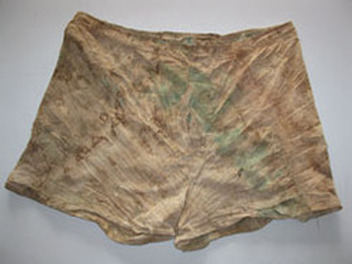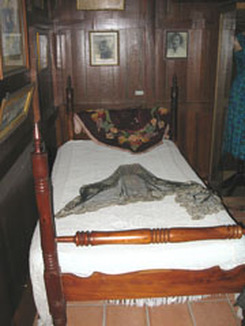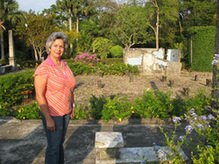U.S. Department of State Grant: Textile Conservation in the Dominican Republic
Museum Textile Services director Camille Myers Breeze received a Speaker and Specialist Grant from the US Department of State in 2009 to consult with museums in the Dominican Republic on issues of textile conservation. Although rich with remarkable cultural institutions and an active museum community, there are no textile conservators in the country.
Museums of the Dominican Resistance
|
The first stop on the one-week trip was to the Museums of the Dominican Resistance in the capitol city of Santo Domingo, which documents, preserves and interprets the long struggle against tyranny and dictatorship that characterized Dominican politics during the 20th century.
Luisa la Penas, their Director, was Camille’s guide throughout her visit. The newest of their museums is dedicated to the Heroes of the Constanza, Maimón and Estero Hondo Expeditions, and is located in newly-opened metro station of the same name. It tells the story of the 198 men from seven countries, including two Americans, who launched attacks against the government of the dictator Trujillo on June 14 and 20th, 1959. All but six men were tortured and killed. The remains of approximately three-quarters of the heroes have been located, exhumed and identified with the aid of physical anthropologists. They are all now interred at the shrine dedicated to the Expeditionists. Many items of clothing have been retrieved and will need conservation in order to preserve them in the hot and humid climate. |
Mirabal Sisters House Museum
|
Another member museum of the Museums of the Dominican Resistance is the Mirabal Sisters House Museum, located approximately two hours into the interior of the island in the town of Salcedo. Three Mirabal sisters, Minerva, Patria and Maria Teresa, are national heroes who were assassinated with their driver on November 25, 1960, by agents of the dictator Trujillo. The surviving sister, Dedé, has done a remarkable job of preserving the memory of her family alongside their homes and possessions, including their clothes and household textiles.
Camille spent two days at the museum and two nights at Dedé’s house, which in itself is almost a museum. With the 50th anniversary of the assassination of her sisters approaching, Dedé was committed to incorporating the improvements Camille suggested in order to ensure that the house museum remains an open and inviting place while preserving its irreplaceable contents. Also nearby are the ruins of the house that sister Patria and her family occupied at the time of the assassinations. It was given as a reward to the man who performed the killings, who dismantled it and used the raw materials to complete another house he was building. The government returned the land to Dedé several years ago and she has maintained the gardens and ruins in excellent condition. |
Centro León
On the way back to the capitol, Camille visited the city of Santiago and the nation’s foremost museum, the Centro León. Named for the enterprising family who built the collection, the Centro León boasts a state-of-the-art facility with climate-controlled storage areas and conservation labs. Their collection of textiles numbers less than 200 but presents many of the issues inherent to organic materials from hot and humid climates. The knowledgeable and dedicated staff is doing an admirable job of caring for their collections and the Centro Leon is looked upon as a model for other museums in the Dominican Republic. Such high standards do not come without high costs, however, and Camille encouraged the museum to include outreach to sister institutions as part of their mission statement.
During her final day in Santo Domingo, Camille presented a lecture in Spanish entitled Caring for Textiles to staff of several museums in the colonial zone. The Colonial Museums, Royal Houses, Cathedral (the oldest in the western hemisphere) and other waterfront institutions fight a constant battle with the tourists, the elements and their aging buildings to provide adequate exhibition and storage conditions. Notable among the collections are several European tapestries from the 16th-18th centuries. All show signs of deterioration exacerbated by decades of permanent exhibition, insect activity and salty, humid air. Camille was able to make suggestions for immediate improvements but the problems will have to be addressed in a future project.
During her final day in Santo Domingo, Camille presented a lecture in Spanish entitled Caring for Textiles to staff of several museums in the colonial zone. The Colonial Museums, Royal Houses, Cathedral (the oldest in the western hemisphere) and other waterfront institutions fight a constant battle with the tourists, the elements and their aging buildings to provide adequate exhibition and storage conditions. Notable among the collections are several European tapestries from the 16th-18th centuries. All show signs of deterioration exacerbated by decades of permanent exhibition, insect activity and salty, humid air. Camille was able to make suggestions for immediate improvements but the problems will have to be addressed in a future project.
Noris Gonzales Mirabal
|
The unexpected surprise of the week was the participation of Noris Gonzalez Mirabal, the daughter of slain sister Patria Mirabal. Noris is passionate about the preservation of the museum’s clothing and textile collection and has been studying textile conservation alongside her career working on reforestation with the department of environmental protection. Noris and Camille spent five days sharing stories and knowledge and emerged as new friends. Noris introduced Camille to other members of the Mirabal family and friends circle, which even includes the manager of the Harley Davidson dealership in Santo Domingo, where Camille got to have drinks and talk bikes with the locals.
This collaboration continued in the fall of 2009 when Noris interned at Museum Textile Services for one month. She stayed with family in near-by Lawrence, Massachusetts. Noris concentrated her internship on conserving the dress her mother Patria wore to Minerva Mirabal’s wedding and a fur cape she remembers as a child. She brought her new skills back to the Dominican Republic and continues to improve the level of conservation of her nation’s invaluable textile patrimony. To learn more about the Mirabal Sisters, watch the movie In the Time of the Butterflies. |




